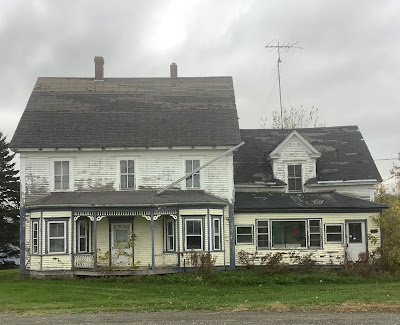I concluded my five days in Maine with a trio of Carnegies in the northeast corner of the state all within twelve miles of one another. The area also included a pair of launching sites for balloonists attempting to cross the Atlantic. I wouldn’t have known if there hadn’t been a road sign pointing towards one of them outside of Presque Isle, where I visited the first of the three Carnegies.
With it raining I didn’t care to make a detour to it, and instead let the librarian tell me what he knew of it. He said the town has had an annual Ballon Festival the past twenty years celebrating the balloon crossings. The first successful one came in 1978 when a trio of balloonists piloted the Double Eagle II across the ocean, which was a big international media event at the time. Six years later someone made the first solo balloon crossing, departing from Caribou, twelve miles north, and home to another Carnegie.
With it raining I didn’t care to make a detour to it, and instead let the librarian tell me what he knew of it. He said the town has had an annual Ballon Festival the past twenty years celebrating the balloon crossings. The first successful one came in 1978 when a trio of balloonists piloted the Double Eagle II across the ocean, which was a big international media event at the time. Six years later someone made the first solo balloon crossing, departing from Caribou, twelve miles north, and home to another Carnegie.
The librarian in Fort Fairfield couldn’t tell me if caribou once roamed in these parts, just that someone had bison and a few had been on the loose a couple of years ago. She showed me a back room that was filled with old books on the Civil War donated by the son of the guy who had collected them decades ago. A plaque above the fireplace paid tribute to the battleship Maine sunk in the Spanish-American war in 1898.
I knew Canada was nearby as for the past seventy-five miles after I reached Houlton just across the border I had been seeing bright red Tim Horton cups of the nation’s most popular fast food franchise.
The agent advised me to go south after crossing the border on the old trans-Canada road paralleling the new superhighway rather than heading east through the interior, as she said there were few towns and lots of logging trucks and the terrain was very hilly. It was to my advantage to be going south as a northerly was predicted for the next day, dropping the temperatures to the thirties for the first time this fall. She said it would be cold camping and fortunately didn’t object that I intended to camp and not at sanctioned campgrounds.
The southern route followed the wide Saint John River with roads on either side and few bridges crossing it. I had the road on the west side pretty much to myself while I had occasional glimpses of 18-wheelers and other vehicles on the busy highway to my right. The road wasn’t as flat as I would have liked, but at least the climbs were gradual and gave me easy pedaling on their downsides.
The southern route followed the wide Saint John River with roads on either side and few bridges crossing it. I had the road on the west side pretty much to myself while I had occasional glimpses of 18-wheelers and other vehicles on the busy highway to my right. The road wasn’t as flat as I would have liked, but at least the climbs were gradual and gave me easy pedaling on their downsides.










No comments:
Post a Comment